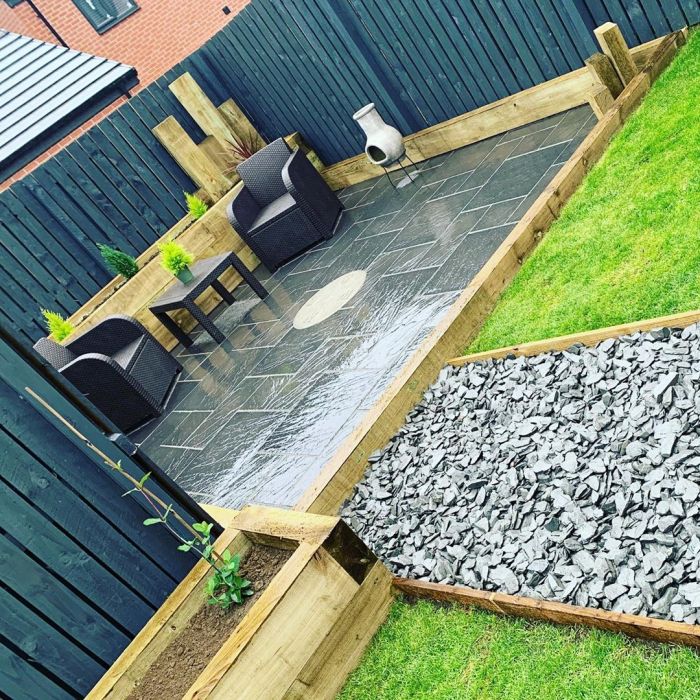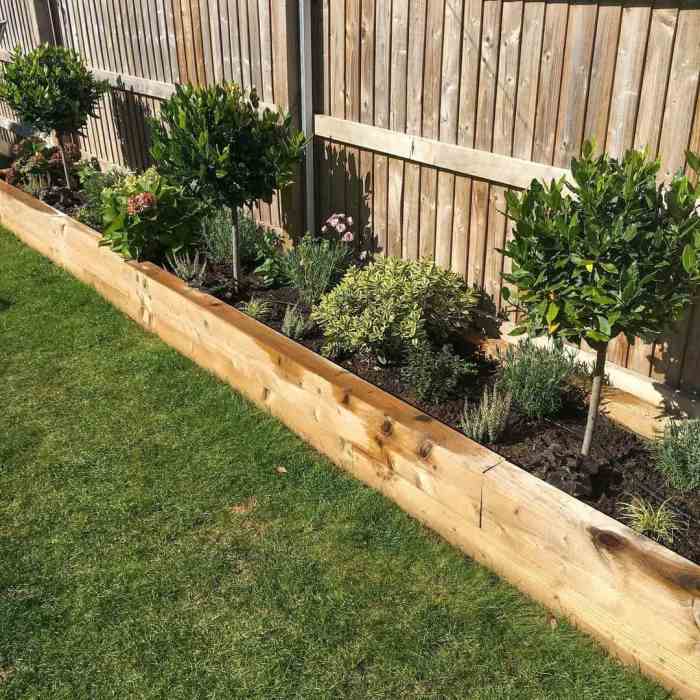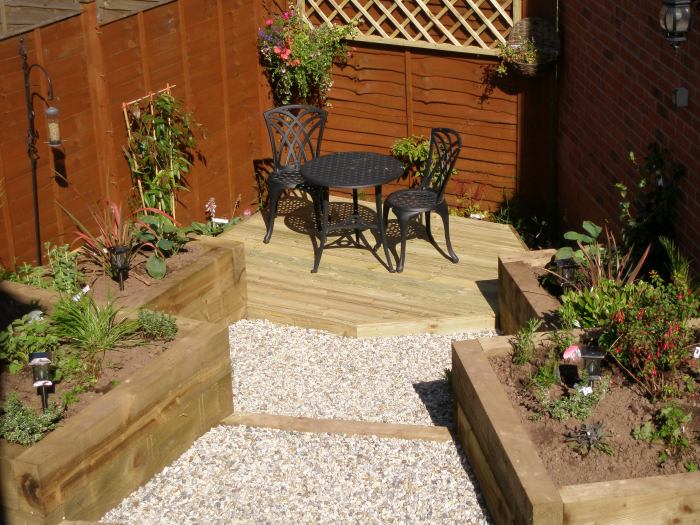Delve into the realm of railway sleeper ideas, where innovation meets functionality. From unique designs that enhance aesthetics to sustainable options that reduce environmental impact, discover the latest trends and best practices in railway sleeper design and implementation.
Uncover the secrets behind heavy-duty railway sleepers that withstand high-traffic lines, explore cost-effective solutions that maintain safety standards, and learn about cutting-edge technologies that promise to revolutionize the railway industry.
Unique Railway Sleeper Design Ideas
Railway sleepers, traditionally used as support structures for railway tracks, have evolved beyond their functional role to become versatile design elements in various landscaping and architectural applications. Innovative designers have conceptualized unique and aesthetically pleasing railway sleeper designs that cater to diverse tastes and functional requirements.
These designs not only enhance the visual appeal of outdoor spaces but also offer practical advantages. They provide durability, versatility, and sustainability, making them a popular choice for both residential and commercial projects.
Geometric Patterns
Geometric patterns, such as herringbone, chevron, and basketweave, add visual interest and create a sense of movement in outdoor spaces. These patterns can be achieved by arranging sleepers in specific angles and orientations, creating dynamic and eye-catching surfaces.
For instance, a herringbone pattern involves laying sleepers in a zigzag formation, while a chevron pattern consists of V-shaped arrangements. Basketweave patterns, on the other hand, resemble woven baskets, adding a touch of texture and depth to the design.
Sustainable Railway Sleeper Options
In line with the growing emphasis on environmental sustainability, the railway industry is exploring eco-friendly alternatives to traditional railway sleepers. These sustainable options offer numerous benefits, including reduced carbon footprint, minimized waste, and enhanced durability.
Various materials are utilized in the production of sustainable railway sleepers, each with its unique characteristics and advantages. These include:
Recycled Plastic
- Derived from post-consumer plastics, recycled plastic sleepers are highly durable and resistant to rot and decay.
- Their production process significantly reduces greenhouse gas emissions compared to traditional timber sleepers.
Concrete
- Concrete sleepers are known for their exceptional strength and longevity, with a lifespan of up to 50 years.
- They are also fire-resistant and require minimal maintenance.
Composite Materials
- Composite sleepers combine recycled materials such as plastic and wood fibers, offering a balance of strength, durability, and environmental friendliness.
- Their lightweight nature facilitates easy installation and reduces transportation emissions.
Heavy-Duty Railway Sleepers for High-Traffic Lines

In high-traffic railway lines, railway sleepers bear the brunt of heavy loads and constant vibrations. To withstand these extreme conditions, heavy-duty railway sleepers are specially designed with enhanced strength and durability.
These sleepers are typically made from high-strength materials such as concrete, steel, or composite materials. They are designed with robust construction methods, including reinforced concrete cores, steel reinforcements, and anti-vibration pads.
Key Features and Specifications
- High compressive strength to withstand heavy axle loads
- Low vibration transmission to minimize track degradation
- Longitudinal and lateral stability to maintain track alignment
- Durability against wear, abrasion, and corrosion
- Resistance to extreme weather conditions and temperature variations
Materials and Construction Methods
Concrete Sleepers:Pre-stressed or reinforced concrete sleepers offer high compressive strength and durability. They are often used in high-speed rail lines and heavy-haul freight lines.
Steel Sleepers:Fabricated from rolled or welded steel sections, steel sleepers provide excellent strength-to-weight ratio and high resistance to wear. They are suitable for high-traffic lines with heavy axle loads.
Composite Sleepers:Combining materials like concrete, steel, and polymers, composite sleepers offer a balance of strength, durability, and vibration dampening properties.
Successful Implementations
Heavy-duty railway sleepers have been successfully implemented in various railway systems worldwide, including:
- China’s high-speed rail network, utilizing concrete sleepers for speeds up to 350 km/h
- Germany’s Deutsche Bahn, employing steel sleepers in heavy-haul freight lines
- Japan’s Shinkansen bullet train lines, using composite sleepers for vibration reduction
Cost-Effective Railway Sleeper Solutions
Railway sleepers, crucial components of rail infrastructure, can significantly impact project costs. Optimizing their design and implementation is essential for cost-effectiveness while maintaining safety and performance standards.
Innovative Materials and Manufacturing Techniques
Advancements in material science have led to the development of innovative railway sleepers that reduce production expenses. Composite sleepers, made from recycled materials and reinforced with fibers, offer durability and cost savings. Concrete sleepers, with their inherent strength and longevity, can also be cost-effective, especially for high-traffic lines.
Railway Sleeper Installation Methods
Railway sleepers are vital components of railway tracks, providing support and stability to the rails. Installing these sleepers requires careful consideration of methods and techniques to ensure a safe and efficient railway system.
Manual Installation
Manual installation involves placing and securing railway sleepers by hand. While it offers flexibility in adjusting sleeper positions, it can be labor-intensive and time-consuming, especially for large-scale projects.
Mechanized Installation
Mechanized installation utilizes specialized machinery to automate the sleeper installation process. This method provides higher efficiency and precision, reducing labor requirements and installation time.
| Manual Installation | Mechanized Installation | |
|---|---|---|
| Efficiency | Lower | Higher |
| Cost | Lower (fewer machines required) | Higher (specialized machinery) |
| Safety | Lower (more manual handling) | Higher (less exposure to hazards) |
| Accuracy | Lower (relies on manual alignment) | Higher (precise machine placement) |
Step-by-Step Manual Installation
- Prepare the track bed by leveling and tamping the ballast.
- Position the sleepers perpendicular to the track axis, ensuring even spacing.
- Secure the sleepers with rail clips or other fastening systems.
- Insert and tighten bolts to fix the rails to the sleepers.
Step-by-Step Mechanized Installation, Railway sleeper ideas
- Use a sleeper laying machine to place sleepers accurately along the track.
- Utilize a ballast regulator to spread and level the ballast around the sleepers.
- Employ a tamper to compact the ballast, securing the sleepers in place.
- Install and fasten the rails to the sleepers using specialized machinery.
Railway Sleeper Maintenance and Inspection
Railway sleepers are essential components of railway tracks, providing support and stability to the rails. Regular maintenance and inspection are crucial to ensure the safety and longevity of railway lines. This involves detecting and repairing damage or defects, assessing the lifespan of sleepers, and planning for timely replacements.
Inspections are typically conducted visually, using specialized equipment to detect cracks, splits, or other damage. Nondestructive testing methods, such as ultrasonic or radiographic testing, may also be employed to assess the internal condition of sleepers.
Repair Techniques
Repairs to damaged sleepers can include filling cracks with epoxy or polyurethane, replacing sections of the sleeper, or installing reinforcement plates. The choice of repair method depends on the extent and location of the damage.
Lifespan Assessment
The lifespan of railway sleepers varies depending on factors such as the type of sleeper, traffic volume, and environmental conditions. Regular inspections and monitoring of sleeper condition help determine the appropriate replacement schedule.
Innovative Railway Sleeper Technologies

Emerging technologies and advancements are revolutionizing railway sleeper design and manufacturing, offering promising solutions to improve safety, reduce maintenance costs, and enhance efficiency. These advancements include:
Composite Sleepers
Composite sleepers, made from a combination of materials like fiberglass, polymers, and recycled plastics, are gaining traction due to their durability, resistance to rot and corrosion, and low maintenance requirements. They offer a longer lifespan compared to traditional wooden or concrete sleepers, reducing replacement frequency and associated costs.
Smart Sleepers
Smart sleepers are equipped with sensors that monitor track conditions, such as temperature, stress, and vibration. This real-time data enables predictive maintenance, allowing railway operators to identify potential issues before they become critical, minimizing disruptions and ensuring safety.
Solar-Powered Sleepers
Solar-powered sleepers incorporate photovoltaic cells to generate electricity, powering sensors and communication devices. This eliminates the need for external power sources, reducing installation and maintenance costs while enhancing sustainability.
Geosynthetic Sleepers
Geosynthetic sleepers are made from high-strength synthetic materials, such as geotextiles and geogrids. They are lightweight, flexible, and can be easily installed, making them suitable for areas with challenging ground conditions or limited access.
Ongoing Research and Development
Ongoing research and development projects are exploring further advancements in railway sleeper technologies, such as:
- Self-healing materials that can repair cracks and damage autonomously, extending the lifespan of sleepers.
- Wireless communication systems that enable real-time monitoring and control of track conditions remotely.
- Advanced manufacturing techniques that optimize sleeper design and reduce production costs.
These innovative technologies hold immense potential to transform the railway industry, improving safety, efficiency, and sustainability. As research and development continue, we can expect even more groundbreaking advancements in railway sleeper design and manufacturing in the future.
Railway Sleeper Market Analysis

The global railway sleeper market is expected to grow significantly in the coming years, driven by increasing demand for rail transportation and infrastructure development.
Key factors driving market growth include rising urbanization, increasing freight traffic, and government initiatives to improve rail networks.
Key Market Trends
- Growing demand for concrete sleepers due to their durability and low maintenance requirements.
- Increasing adoption of composite sleepers as an alternative to traditional wooden sleepers.
- Rising popularity of eco-friendly sleepers made from recycled materials.
Challenges and Opportunities
The railway sleeper market faces challenges such as rising raw material costs and competition from other industries for resources.
Opportunities for manufacturers and suppliers include developing innovative sleeper designs, exploring new markets, and expanding production capacity.
Case Studies of Railway Sleeper Implementations

Delve into real-world triumphs of railway sleeper implementations. Explore the challenges confronted and the ingenious solutions employed, quantifying the tangible benefits realized, such as enhanced track stability, reduced maintenance costs, and accelerated train speeds.
The Revitalization of the Trans-Siberian Railway
The vast expanse of the Trans-Siberian Railway posed significant challenges, with its extreme weather conditions and heavy freight traffic. By implementing concrete sleepers reinforced with steel, the railway achieved exceptional track stability, enabling higher train speeds and increased freight capacity.
The High-Speed Rail Success in Japan
Japan’s high-speed rail network, renowned for its efficiency and speed, utilized pre-stressed concrete sleepers. These sleepers facilitated precise track alignment, minimizing vibration and ensuring smooth, high-speed operation.
Ultimate Conclusion
Whether you’re an engineer seeking innovative solutions, a contractor searching for sustainable materials, or simply fascinated by the world of railway infrastructure, this comprehensive guide to railway sleeper ideas has something for you. Embrace the possibilities and discover how railway sleepers can transform your projects and enhance the efficiency and safety of railway systems worldwide.
FAQ: Railway Sleeper Ideas
What are the benefits of using unique railway sleeper designs?
Unique railway sleeper designs can enhance aesthetics, improve functionality, reduce noise and vibration, and provide opportunities for customization.
How can I ensure the sustainability of my railway sleeper project?
Consider using eco-friendly materials, such as recycled plastic or composite materials, and opt for designs that minimize waste and promote durability.
What are the key factors to consider when selecting railway sleepers for high-traffic lines?
Strength, durability, and resistance to wear and tear are crucial factors for railway sleepers in high-traffic areas.


